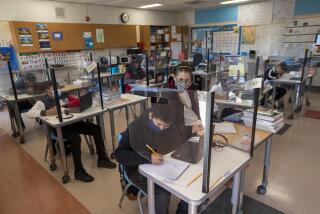Look Beyonf Learning English
- Share via
The old joke goes something like this:
What do you call a person who speaks three languages? Trilingual.
A person who speaks two languages? Bilingual.
And a person who speaks only one language? American.
Americans may not be aware of their insularity, but there are signs of change. The John Stanford International School in the Seattle school district teaches two languages. Kindergartners and first-graders spend half the day being taught in English and the other half in Spanish. The school has become so popular that a second one will be opened soon.
The advantages of the kind of bilingualism fostered at the Stanford school are obvious and will become a definite asset in an ever-shrinking world. Bilingual/bicultural kids have many advantages over monolingual ones because they possess what researchers call a “plasticity” of the brain. This trait becomes apparent when they try to learn a third language. It’s the first foreign language that is hardest to learn.
But it’s not just language learning that becomes easier. Bilingual/bicultural individuals realize that just as there are two ways to say the same thing, there are two ways to learn new things or solve problems. Bilingual children develop a mental agility and flexibility about learning that monolinguals lack.
Although English and Spanish bilingualism may be easiest to achieve and the most desirable, the practical and intellectual benefits of bilingualism may be reached with other languages. French, Japanese, or some other crucial language could easily take the place of Spanish in some parts of the country.
This second language should become part of the curriculum for the long haul; to gain fluency, students need to study it for about five or six years, according to George Mason University researchers.
Other countries understand the importance of languages. With an economy aimed primarily at exporting, the Japanese firmly believe that in order to sell their products they have to know the customers--and that means the customers’ language. In Japan, English is taught from the earliest grades on. The Japanese know that learning languages requires a long time and they give their students the time it takes.
Learning about future customers is not just a matter of learning their words. The study of culture--history, geography, politics, traditions--goes hand in hand with language. The Japanese are not alone in understanding the importance of starting the study of foreign languages in the early grades. By the time Dutch students are in high school, they are fluent in English and have been exposed to a second foreign language.
In most countries around the world, any educated person will be able to communicate in several languages in addition to their native tongue.
The U.S. has a long way to go before it can match other countries’ interest in languages, but some encouraging signs are beginning to occur. John Stanford International School is only one of the 261 “dual language” schools in the United States. These schools differ from the bilingual education programs aimed at students who don’t speak English. The goal of dual language programs is for all students to learn English as well as another language. The number of dual language schools has been rising rapidly, increasing by about two-thirds since 1992.
In today’s world, events a continent away can have dramatic effects here. A slide in Asian stock markets can trigger one in New York. To understand these events and be able to influence them we need linguistic and cultural knowledge that goes beyond English.
More to Read
Sign up for Essential California
The most important California stories and recommendations in your inbox every morning.
You may occasionally receive promotional content from the Los Angeles Times.













